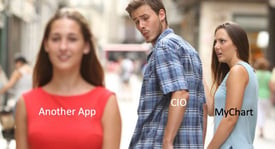A meme was shared on the Twitter machine last week that caught my eye. It’s the very frequently-used photo of a young man walking with his girlfriend at his side, but instead of making eye contact with her, he’s looking at a different woman walking in the other direction. His girlfriend is not amused. Yeah, you know the one. To meme-ify (it’s a word if I say it’s a word) the photo, text is applied to all three parties so that they represent more than the moment that was photographed.
 The tweet I’m referencing from Chinmay A. Singh shows the healthcare CIO holding hands with MyChart (Epic’s patient portal for the uninitiated) but looking jealously at Another App. This is…hilarious. Why? Because it’s true, that’s why!
The tweet I’m referencing from Chinmay A. Singh shows the healthcare CIO holding hands with MyChart (Epic’s patient portal for the uninitiated) but looking jealously at Another App. This is…hilarious. Why? Because it’s true, that’s why!
It’s just human nature: even though we might have something very good, we’re always on the hunt for something that might be just a tiny bit better. Sure, Epic is one of the biggest players in the international electronic health record (EHR) market, and its patient portal is top-rated by KLAS and others, but…what about Another App?
CIO Will Weider (Peace Health) commented that, “We need to replace the CIO with others in the C-suite.” I won’t argue with him. In my experience, while sometimes it’s the CIO or CTO who wants to keep looking for something better or cooler or sexier, more often it is others in the C-suite or senior leaders who are pushing for the New Thing (reminds me of a MacGuffin). From an IT-budgetary perspective, I’ve often thought it dangerous to allow the healthcare COO or CMO to go to conferences or talk with their colleagues. They hear “stories” about successes that others ascribe to Another App. They want that app. They need that app!
I get it. Really, I do. The app that I don’t have is often better at playing a specific role or offering a key function. It can do that one thing that our enterprise system (hello Cerner, Epic, Meditech, and others!) can’t seem to nail down in just the way we (or our leadership team members) want. For example, I often hear comments like, “The cardiology module from our EHR vendor is pretty good, but it just doesn’t let me manipulate the anatomy drawings for unusual cases, and Another App really crushes that. It’s awesome!” This is all well and good, and the immediate response from non-IT folks is, “Let’s get it!” But there’s a problem, Houston. Rather, a few problems.
The first potential problem with “adding an app” to the core EHR is difficult to overcome: it’s impossible. Sometimes, the system is just not designed to be extended, and that’s that. Just can’t be done. This is the more intractable, yet thankfully less common, issue. The second problem can be overcome: money. It costs money to interface the core EHR to an app. You need to pay EDI experts to ensure that all the programs are “talking” to each other in the same way. This sounds easy; it most assuredly is not easy. And there’s a third problem: even if it’s technically possible to connect, and even if you have the funds to pay for it, you still have to find the right person for the job. There aren’t enough interface engineers to go around, so even if you’re well-funded, you still have to find the talent.
While we all want to live in a world where healthcare software is fully plug-and-play and interoperable, and while the ONC is trying to get us there one regulation at a time, we most certainly are not there today. In today’s world, there are typically benefits to using our enterprise EHR’s specialty modules. Often, the built-in features get us 80-90% of what we need. It’s that last 10-20% where we struggle. “The drawing software to describe cardiac anatomy as seen on echocardiograms is mostly great, but…I love the way that Other App handles the unusual stuff. Oh, why can’t we just plug in the Other App right here in the workflow?”
The answer is…because it doesn’t (yet) work that way. Depending on your point of view, it might not work that way today because the big vendors have been financially incentivized to make it difficult to bolt on outside software. A more charitable explanation might be that it is just often difficult to design software with hooks everywhere so that a mix-and-match approach can be successfully executed. Whatever your take, the outcome is the same: you can either have the enterprise solution (gets you 80-90% of what you need) or you can have a grab bag of different Other Apps (you may get some cool things, but typically miss out on various meat-and-potato items). Most folks with whom I’ve worked choose the former.
What’s a poor CIO to do? You can try to lock up your other C-suite colleagues and not allow them to communicate with their friends, but while I’m no lawyer, this may technically lead to felony charges. A safer course of action is to evaluate what the Other App does and see if/how it can be incorporated. Heck, you may even find that your meat-and-potatoes software can be tweaked or upgraded to do exactly what’s needed. Either way, there are no easy answers. If there were, we wouldn’t have the meme, now, would we?
In an upcoming blog post, I’ll discuss what might happen if a healthcare system is super great at incorporating Other Apps. Hint: feral cats may be referenced!